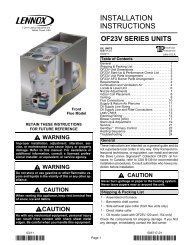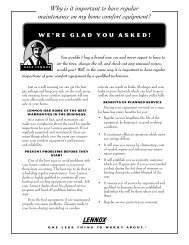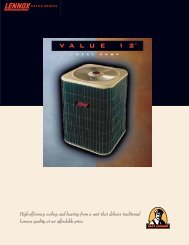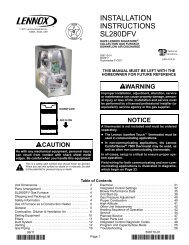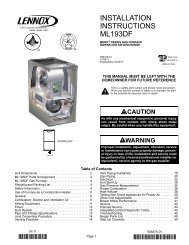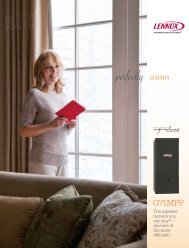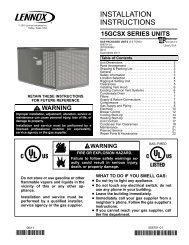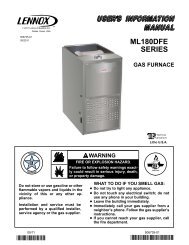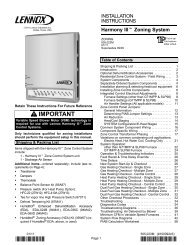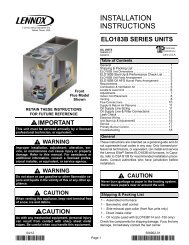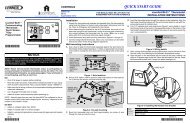INSTALLATION INSTRUCTIONS - Lennox
INSTALLATION INSTRUCTIONS - Lennox
INSTALLATION INSTRUCTIONS - Lennox
You also want an ePaper? Increase the reach of your titles
YUMPU automatically turns print PDFs into web optimized ePapers that Google loves.
CAUTION<br />
Do not install the furnace in a corrosive or contaminated<br />
atmosphere. Meet all combustion and ventilation<br />
air requirements, as well as all local codes.<br />
All gas-fired appliances require air for the combustion process.<br />
If sufficient combustion air is not available, the furnace<br />
or other appliance will operate inefficiently and unsafely.<br />
Enough air must be provided to meet the needs of all<br />
fuel−burning appliances and appliances such as exhaust<br />
fans which force air out of the house. When fireplaces, exhaust<br />
fans, or clothes dryers are used at the same time as<br />
the furnace, much more air is required to ensure proper<br />
combustion and to prevent a downdraft. Insufficient air<br />
causes incomplete combustion which can result in carbon<br />
monoxide.<br />
In addition to providing combustion air, fresh outdoor air dilutes<br />
contaminants in the indoor air. These contaminants<br />
may include bleaches, adhesives, detergents, solvents<br />
and other contaminants which can corrode furnace components.<br />
The requirements for providing air for combustion and ventilation<br />
depend largely on whether the furnace is installed in<br />
an unconfined or a confined space.<br />
Unconfined Space<br />
An unconfined space is an area such as a basement or<br />
large equipment room with a volume greater than 50 cubic<br />
feet (1.42 m 3 ) per 1,000 Btu (.29 kW) per hour of the combined<br />
input rating of all appliances installed in that space.<br />
This space also includes adjacent rooms which are not<br />
separated by a door. Though an area may appear to be unconfined,<br />
it might be necessary to bring in outdoor air for<br />
combustion if the structure does not provide enough air by<br />
infiltration. If the furnace is located in a building of tight<br />
construction with weather stripping and caulking around<br />
the windows and doors, follow the procedures in the air<br />
from outside section.<br />
Confined Space<br />
A confined space is an area with a volume less than 50 cubic<br />
feet (1.42 m 3 ) per 1,000 Btu (.29 kW) per hour of the com−<br />
bined input rating of all appliances installed in that space. This<br />
definition includes furnace closets or small equipment rooms.<br />
When the furnace is installed so that supply ducts carry air<br />
circulated by the furnace to areas outside the space containing<br />
the furnace, the return air must be handled by ducts<br />
which are sealed to the furnace casing and which terminate<br />
outside the space containing the furnace. This is especially<br />
important when the furnace is mounted on a platform in a<br />
confined space such as a closet or small equipment room.<br />
Even a small leak around the base of the unit at the platform<br />
or at the return air duct connection can cause a potentially<br />
dangerous negative pressure condition. Air for combustion<br />
and ventilation can be brought into the confined space either<br />
from inside the building or from outside.<br />
Air from Inside<br />
If the confined space that houses the furnace adjoins a<br />
space categorized as unconfined, air can be brought in by<br />
providing two permanent openings between the two<br />
spaces. Each opening must have a minimum free area of 1<br />
square inch (645 mm 2 ) per 1,000 Btu (.29 kW) per hour of<br />
total input rating of all gas−fired equipment in the confined<br />
space. Each opening must be at least 100 square inches<br />
(64516 mm 2 ). One opening shall be within 12 inches (305<br />
mm) of the top of the enclosure and one opening within 12<br />
inches (305 mm) of the bottom. See figure 3.<br />
EQUIPMENT IN CONFINED SPACE − ALL AIR FROM INSIDE<br />
ROOF TERMINATED<br />
EXHAUST PIPE<br />
SIDE WALL<br />
TERMINATED EX-<br />
HAUST PIPE (ALTER-<br />
NATE LOCATION)<br />
G43UF<br />
OPENINGS<br />
(To Adjacent<br />
Unconfined<br />
Space)<br />
NOTE − Each opening shall have a free area of at least one square<br />
inch per 1,000 Btu (645mm 2 per .29kW) per hour of the total input<br />
rating of all equipment in the enclosure, but not less than 100 square<br />
inches (64516mm. 2).<br />
FIGURE 3<br />
Air from Outside<br />
If air from outside is brought in for combustion and ventilation,<br />
the confined space shall be provided with two permanent<br />
openings. One opening shall be within 12" (305mm)<br />
of the top of the enclosure and one within 12" (305mm) of<br />
the bottom. These openings must communicate directly<br />
or by ducts with the outdoors or spaces (crawl or attic) that<br />
freely communicate with the outdoors or indirectly<br />
through vertical ducts. Each opening shall have a minimum<br />
free area of 1 square inch per 4,000 Btu (645mm 2<br />
per 1.17kW) per hour of total input rating of all equipment<br />
in the enclosure. When communicating with the outdoors<br />
through horizontal ducts, each opening shall have a minimum<br />
free area of 1 square inch per 2,000 Btu (645mm 2<br />
per .59kW) per total input rating of all equipment in the enclosure<br />
(See figure 4).<br />
Page 7



